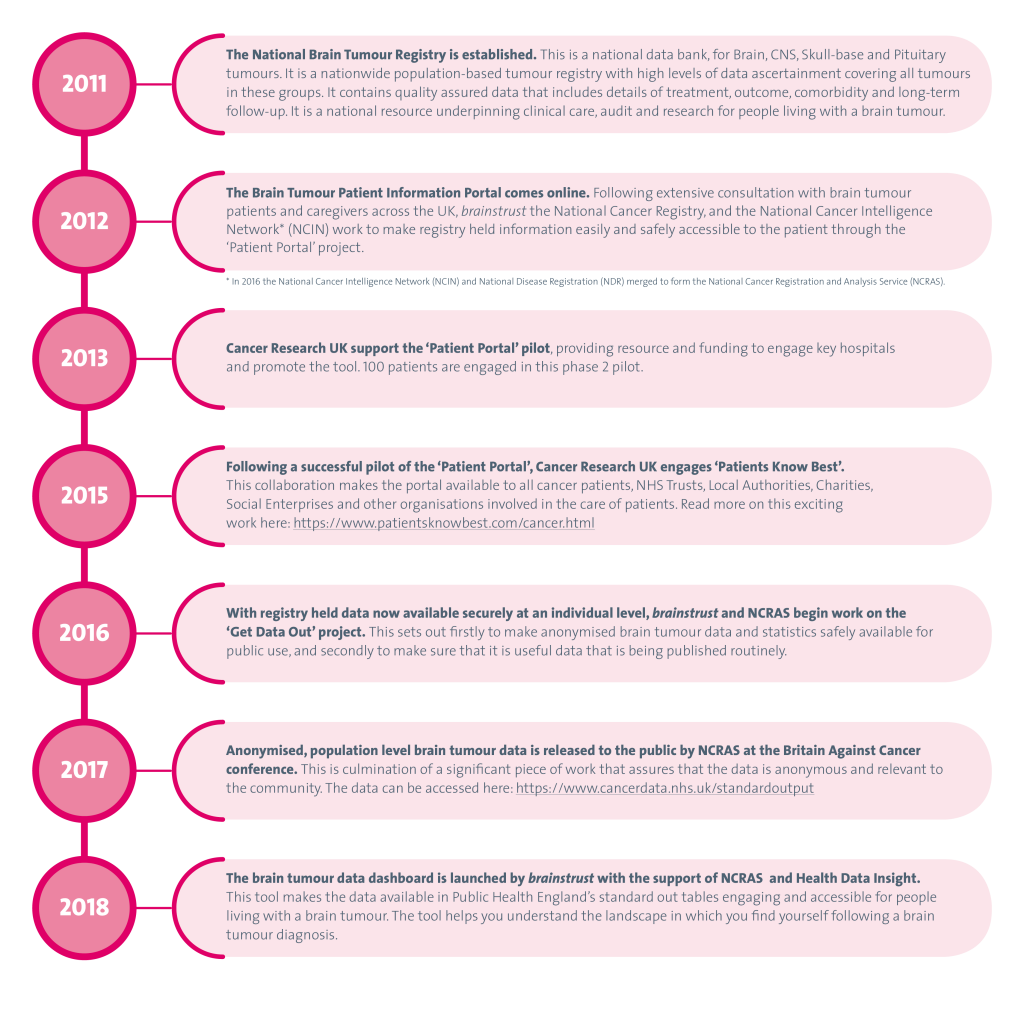 May 2018 sees the launch of the Brain Tumour Data Dashboard. This new tool has been designed to help you navigate and understand brain tumour data.
May 2018 sees the launch of the Brain Tumour Data Dashboard. This new tool has been designed to help you navigate and understand brain tumour data.
Why is brain tumour data important?
When you have been diagnosed with a brain tumour, we know that understanding the landscape you are in is key to helping you make decisions. You might want to know more about brain tumour survival rates in your area, for your age group, or how people near you were diagnosed. You may also want to know what sort of treatment people like you might be getting. The Brain Tumour Data Dashboard helps you to explore questions like this.
The data you can explore
For launch, the Brain Tumour Data Dashboard includes data on:
- brain tumour survival
- chemotherpay
- radiotherapy
- routes to diagnosis
The data is being updated regularly, and represents the most up-to-date and complete population level data available, and new fields (like brain tumour surgery) will be added in the future.
It’s your data
When a person is diagnosed with cancer in the UK information about them is automatically included in their national cancer registry. There are registries for England, Wales, Northern Ireland and Scotland.
It is data from cancer registries that tells us how many people are diagnosed with cancer, what treatments they have, how long they live, and whether this is getting better or worse. This information can then be used to help plan cancer services and identify where further progress is needed in order to improve the lives of all people affected by cancer.
Read more about cancer registration here
Clearly, cancer data is important for doctors, researchers and NHS managers. But we believe that as it is your data, you too should be able to access it in a meaningful way. This matter of principle is a key reason why we have been working hard at brainstrust for you to have access to this data. This is why we have been heavily committed to projects like the Patient Information Portal, and this Brain Tumour Data Dashboard.
Working in partnership for meaningful, safe and secure brain tumour data
Your data should only be collected if it is going to be useful, and also used. Your data should only be used to improve treatment, care and ultimately survival.
We are working at a national level, with NCRAS who have a track record of producing meaningful population level data that drives change for people with cancer rather than starting a new registry (or data bank). We know that to be meaningful (or useful) data has to be population based, and it must be as complete as possible. Incomplete data does not paint an accurate picture and is therefore misleading. For us to understand brain tumours, we must look at population level data.
The cancer registry aims to include information on all cancer patients. This is because the more complete the cancer registries are, the more useful they are.
The completeness of the registry is most important when trying to understand things that only affect a small number of people of people. For example:
- Rarer and less common cancers (brain tumours are classified as a ‘less common’ cancer)
- A potential cause of cancer in a small group e.g. children who live near a power line
Safety is also an important consideration when sharing data, and we know that cancer registries take great care to keep the information they hold about you confidential with strict ethical safeguards in place and access is strictly controlled. To make this data available to you via the brain tumour data dashboard, the NCRAS has developed stringent criteria and strict process that must be adhered to in order to ensure that data remains completely anonymous. This has been a key part of the ‘Get Data Out’ project, which you can read about here.
What you will see in the Brain Tumour Data Dashboard
The information you see represents the most up-to-date, official, population level brain tumour data available for England and Wales. Over time we will be adding to the brain tumour data available and publishing reports, with recommendations, as a result of what we learn from this data.
The brain tumour data timeline






